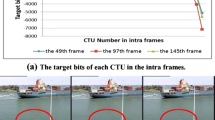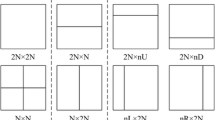Abstract
Rate control plays a crucial role in video coding. Existing rate control methods for high efficiency video coding standard (HEVC) hardly take advantage of spatio-temporal context information when updating model parameters, resulting in inaccurate computation of the Lagrange multiplier and quantization parameter (QP). Meanwhile, these methods fail to consider the motion complexity of a basic unit (BU). Therefore, a large mismatch may exist between the allocated bits and actually encoded bits. In this paper, we propose an effective rate control scheme for HEVC at the BU layer to exploit both the spatio-temporal context and motion complexity. Firstly, the actually used Lagrange multiplier and generated bits of the highly correlated coded BUs in the spatio-temporal context are carefully weighted to update the model parameters. Secondly, the allocated bits for a BU are adjusted based on its motion complexity. Thus, an improved Lagrange multiplier is more accurate in minimizing the difference between the target bits and actually generated bits. Experimental results show that our proposed method outperforms the current scheme in HM with negligible complexity increase.




Similar content being viewed by others
References
Bossen F (2012) Common test conditions and software reference configurations. JCTVC-J1100, 10-th JCTVC meeting, Stockholm, Sweden, July. 2012
Bross B et al (2013) High efficiency video coding (HEVC) text specification draft 10. JCTVC-L1003, 12-th JCTVC meeting, Geneva, Switzerland, Jan. 2013
Bjontegaard G (2001) Calculation of average PSNR differences between RD-Curves. In: Proc. ITU-T Q.6/SG16 VCEG 13th Meeting, Austin, TX, Apr. 2001, document VCEG-M33
Chiang T, Zhang Y (1997) A new rate control scheme using quadratic rate distortion model. IEEE Trans Circuits Syst Video Technol 7(2):287–311
Choi H, Yoo J, Nam J, Sim D, Ivan VB (2013) Pixel-wise unified rate-quantization model for multi-level rate control. IEEE J Sel Top Sign Proces 7 (6):1112–1123
Corbera J, Lei S (1997) Rate control for low-delay video communications. ITU Study Group 16, Video Coding Experts Group, Porland, Documents Q15-A-20, 1997
He Z, Mitra S (2002) Optimum bit allocation and accurate rate control for video coding via ρ-domain source modeling. IEEE Trans Circuits Syst Video Technol 12(10):840–849
Jiang M, Ling N (2005) On enhancing H.264/AVC video rate control by PSNR-based frame complexity estimation. IEEE Trans Consum Electron 51(1):281–286
Kamaci N, Altinbasak Y, Mersereau RM (2005) Frame bit allocation for H.264/AVC video coder via Cauchy density-based rate and distortion models. IEEE Trans Circuits Syst Video Technol 15(8):994–1006
Katto J, Ohta M (1995) Mathematical analysis of MPEG compression capability and its application to rate control. In: Proc. IEEE ICIP, Washington D.C., pp. 555–559
Kim IK, Min J, Lee T, Han WJ, Park J (2012) Block partitioning structure in the HEVC Standard. IEEE Trans Circuits Syst Video Technol 22(12):1697–1706
Kwon D, Shen M, Jay Kuo CC (2007) Rate control for H.264 video with enhanced rate and distortion models. IEEE Trans Circuits Syst Video Technol 17 (5):517–529
Lee B, Kim M, Nguyen TQ (2014) A frame-level rate control scheme based on texture and non-texture rate models for High Efficiency Video Coding. IEEE Trans on Circuits and Syst Video Tech 24(3):465–479
LI ZG, Pan F, Lim KP, Feng GN (2003) Adaptive basic unit layer rate control for JVT. In: Joint Video Team of ISO/IEC MPEG and ITU-T VCEG, JVT-G012, 7th Meeting, Pattaya, Thailand, 2003, pp. 7C14, JVT-G012
Li B, Li H, Li L, Zhang J (2013) Adaptive bit allocation for R-lambda model rate control in HM. JCTVC-M0036, 13-th JCTVC meeting, Shanghai, Apr. 2013
Li B, Li H, Li L, Zhang J (2014) λ domain based rate control for High Efficiency Video Coding. IEEE Trans Image Process 23(9):3841–3854
Li ZG, Pan F, Lim KP, Feng G, Lin X, Rahardja S (2003) Adaptive basic unit layer rate control for JVT. presented at the 7th JVT Meeting, JVT-G012-rl, Pattaya, Thailand, Mar. 2003
Ma S, Gao W, Lu Y (2005) Rate-distortion analysis for H.264/AVC video coding and its application to rate control. IEEE Trans Circuits Syst Video Technol 15 (12):1533–1544
Mallat S, Falzon F (1998) Analysis of low bit rate image transform coding. IEEE Trans Image Process 46:1027–1042
Mller F (1993) Distribution shape of two-dimensional DCT coefficients of natural images. Electron Lett 29(22):1935–1936
Ohm JR, Sullivan GJ, Schwarz H, Tan TK, Wiegand T (2012) Comparison of the coding efficiency of video coding standards C including High Efficiency Video Coding (HEVC). IEEE Trans Circuits Syst Video Technol 22(12):1669–1684
Seo C-W, Moon J-H, Han J-K (2013) Rate control for consistent objective quality in high efficiency video coding. IEEE Trans Image Process 22(6):2442–2454
Sullivan G, Wiegand T (1998) Rate-distortion optimization for video compression. IEEE Signal Process Mag 15:74–90
Sullivan GJ, Ohm JR, Han WJ, Wiegand T (2012) Overview of the High Efficiency Video Coding (HEVC) standard. IEEE Trans Circuits Syst Video Technol 22(12):1649–1668
Vanne J, Viitanen M, Hmlinen TD, Hallapuro A (2012) Comparative rate-distortion-complexity analysis of HEVC and AVC video codecs. IEEE Trans Circuits Syst Video Technol 22(12):1885–1898
Wang Z, Sheikh HR, Bovik AC, Simoncelli EP (2004) Image quality assessment: From error visibility to structural similarity. IEEE Trans Image Process 13(4):600–612
Wang S, Ma S, Wang S, Zhao D, Gao W (2013) Rate-GOP based rate control for High Efficiency Video Coding. IEEE J Sel Top Sign Proces 7(6):1101–1111
Yuan W, Lin S, Zhang Y, Luo H (2005) Optimum bit allocation and rate control for H.264/AVC. Joint Video Team of ISO/IEC JTC1/SC29/WG11 and ITU-T SG16/Q.6, Doc. JVT-O016, 15th Meeting, Busan, Korea, Apr. 2005
Yuan Y, Kim IK, Zheng X, Liu L, Cao X, Lee S, Cheon MS, Lee T, He Y, Park JH (2012) Quadtree based non-square block structure for inter frame coding in HEVC. IEEE Trans Circuits Syst Video Technol 22(12):1707–1719
Author information
Authors and Affiliations
Corresponding author
Rights and permissions
About this article
Cite this article
Hou, Y., Ye, Y., Lei, J. et al. Rate control for HEVC based on spatio-temporal context and motion complexity. Multimed Tools Appl 76, 14035–14053 (2017). https://doi.org/10.1007/s11042-016-3784-5
Received:
Revised:
Accepted:
Published:
Issue Date:
DOI: https://doi.org/10.1007/s11042-016-3784-5




